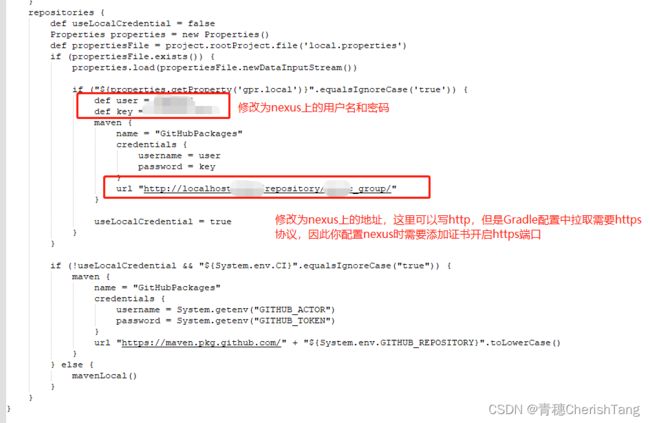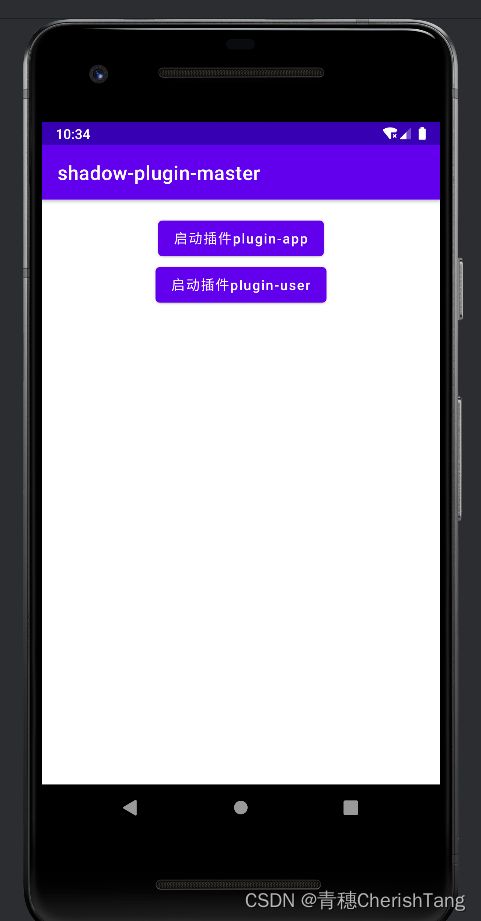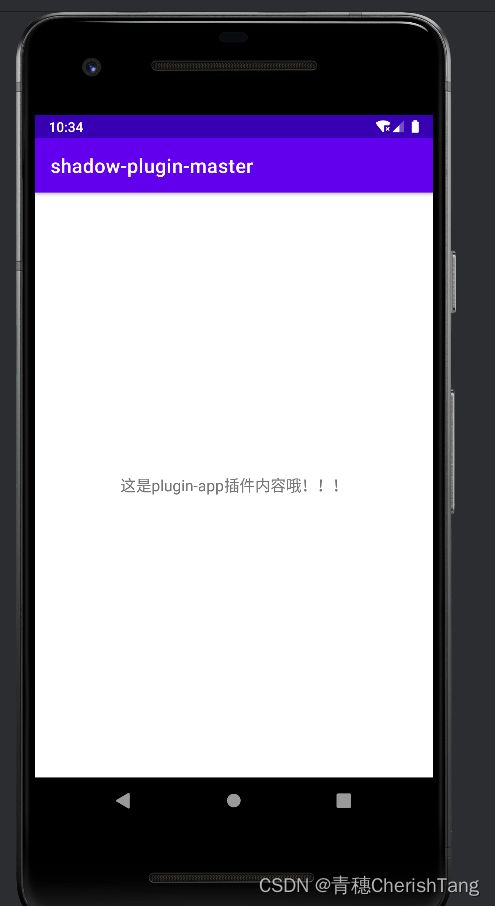Android Tencent Shadow 插件接入指南
Android Tencent Shadow 插件接入指南
- 插件化简述
-
- 一、clone 仓库
- 二、编译运行官方demo
- 三、发布Shadow到我们本地仓库
-
- 3.1、安装Nexus 3.x版本
- 3.2、修改发布配置
- 3.3、发布仓库
- 3.4、引用仓库包
- 四、编写我们自己的代码
-
- 4.1、新建项目导入maven等共同配置
-
- 4.1.1、导入buildScript
- 4.1.2、修改gradle版本和插件包版本
- 4.1.3、添加maven依赖
- 4.2、实现宿主模块
-
- 4.2.1、添加依赖
- 4.2.2、撸码
- 4.3、静态参数 constant 的module编写
- 4.4、plugin-loader模块实现
- 4.5、plugin-manager的实现
- 4.6、plugin-runtime实现
- 4.7、插件项目的实现
- 4.8、宿主调用插件Activity
- 4.9、启动项目
- 4.10、运行看看新效果吧
- 五、踩坑
-
- 5.1、插件项目的清单文件中一定要添加package
- 5.2、每个插件项目的build.gradle中都要引用插件
- 5.3、每个插件都要添加依赖
- 5.4、注意gradle版本官方推荐
- 5.5、注意修改每个build.gradle中的版本号
- 5.6、注意修改我文中没有提到的包名
- 5.7、官方建议
- 5.8、几个插件就要新建一个service并且进行不能再统一进程
- 5.9、注意包名不要错和,尽量partKey和module名保持一致,这样可以减少容错率
- 5.10、注意看文中的每一个注释代码
- 六、写在最后
插件化简述
关于插件化的概念就不提了大家可以自行百度!
插件化难点痛点在于AndroidManifest.xml清单文件,如果不是清单文件注册其实就不需要什么高深技术了,可以通过反射等等方式实现很简单。因此市场上很多插件化的框架都是通过占位去实现的,但是由于Android 9.0后私有API权限的问题,基本市场上的框架都停止了对其的维护,大家可以搜一搜基本都是只支持到9.0。那么问题来了仅仅只支持到9.0怎么够呢?Android已经13了,马上就14了!所以今天给大家介绍下shadow的接入。他的介绍啊简述啊我就不重复复制了,给大家甩几个网址:
Shadow作者解析:https://juejin.cn/user/536217405890903/posts
别人录制的B站视频:https://www.bilibili.com/video/BV1u14y1f7v8/?spm_id_from=333.337.search-card.all.click&vd_source=0f8f0025ace2f1265a86bba19aa4778d
别人写的博客:
https://www.jianshu.com/p/f00dc837227f
本文demo:https://github.com/fzkf9225/shadow-plugin-master
一、clone 仓库
首先我们克隆官方仓库代码:
https://github.com/Tencent/Shadow
二、编译运行官方demo
在 Shadow 目录下使用命令, 确保在 Java8 环境:
./gradlew build
或者直接点击他们项目根目录下的脚本文件
gradlew.bat
三、发布Shadow到我们本地仓库
3.1、安装Nexus 3.x版本
大家可以下载一个nexus,具体操作可以自行百度搞定它,3.x Nexus很无脑的,记得配置https证书和端口:https://help.sonatype.com/repomanager3/product-information/download
3.2、修改发布配置
修改Shadow框架中的maven.gradle和common.gradle配置,在根目录下的buildScript中。其中有github相关配置,可改可不改,不重要,主要是修改如下部分因为源码都有所以直接截图了:

可以先在 buildScripts/gradle/common.gradle 路径下,修改发布版本或其他信息:
ext.ARTIFACT_VERSION = ext.VERSION_NAME + ext.VERSION_SUFFIX
直接修改为你想要的版本号:
ext.ARTIFACT_VERSION = 1.0
3.3、发布仓库
使用命令或者自行百度如何发布到nexus的maven仓库
./gradlew publish
3.4、引用仓库包
发布成功后即可在Shadow框架目录下找到pom文件如图

怕有人不知道怎么用我多说一句:
在需要引用的build.gradle中加入:
##对应上图
implementation "groupId:artifactId:version"
示例:
implementation "com.tencent.shadow.core:common:1.0"
为了防止回头升级导致的大量修改版本号,我们可以新增一个全局配置shadow_version,注意系统导包的时候是单引号,我们引用参数需要改为双引号
#错误
implementation 'com.tencent.shadow.core:common:$shadow_version'
#正确
implementation "com.tencent.shadow.core:common:$shadow_version"
四、编写我们自己的代码
4.1、新建项目导入maven等共同配置
- app包名:推荐:com.域名.项目名,示例:com.casic.titan.shadow
- common:没啥好解释的,基础封装module而已
- constant:静态参数module,其实你可以不用,但是好几个module都需要各自写魔法值,容易错,不如加个module
- plugin-app包名:推荐:com.域名.项目名,示例:com.casic.titan.shadow,为了演示官方推荐和素质包名一致
- pliugin-loader:推荐:com.域名.loader,示例:com.casic.titan.loader
- plugin-manager:推荐:com.域名.manager,示例:com.casic.titan.manager
- plugin-runtime:推荐:com.域名.runtime,示例:com.casic.titan.runtime
- plugin-user:推荐:com.域名.随意,示例:com.casic.titan.user,记得再gradle中加上脚本配置(后面会提到)
4.1.1、导入buildScript
复制shadow项目下的buildScript目录中的common.gradle和version.gradle文件,其实也可以不复制但是添加公共的模块会节省很多事情,复制后我们稍作修改
common.gradle如下:
def gitShortRev() {
def gitCommit = ""
def proc = "git rev-parse --short HEAD".execute()
proc.in.eachLine { line -> gitCommit = line }
proc.err.eachLine { line -> println line }
proc.waitFor()
return gitCommit
}
allprojects {
ext.COMPILE_SDK_VERSION = 31
ext.MIN_SDK_VERSION = 24
ext.TARGET_SDK_VERSION = 31
ext.VERSION_CODE = 1
if ("${System.env.CI}".equalsIgnoreCase("true")) {
ext.VERSION_NAME = System.getenv("GITHUB_REF_SLUG")
} else {
ext.VERSION_NAME = "local"
}
//System.env是获取window环境变量,不用管他
if ("${System.env.PUBLISH_RELEASE}".equalsIgnoreCase("true")) {
ext.VERSION_SUFFIX = ""
} else if ("${System.env.CI}".equalsIgnoreCase("true")) {
ext.VERSION_SUFFIX = "-${System.env.GITHUB_SHA_SHORT}-SNAPSHOT"
} else {
ext.VERSION_SUFFIX = "-${gitShortRev()}-SNAPSHOT"
}
ext.ARTIFACT_VERSION = ext.VERSION_NAME + ext.VERSION_SUFFIX
ext.TEST_HOST_APP_APPLICATION_ID = 'com.casic.titan.test.shadow'//你测试的applicationId
ext.SAMPLE_HOST_APP_APPLICATION_ID = 'com.casic.titan.shadow'//你项目的applicationId
}
version.gradle如下
constraintlayoutVersion=2.1.3
materialVersion=1.5.0
appcompatVersion=1.4.1
espressoCoreVersion=3.4.0
shadow_version=1.0
compileSdk=31
minSdk=24
targetSdk=31
javassist_version=3.28.0-GA
4.1.2、修改gradle版本和插件包版本
现在新版Android Studio新建的项目默认都是8.0版本了但是Shadow不支持我们需要修改一下
a)修改项目根目录下的builde.gradle
plugins {
id 'com.android.application' version '7.0.3' apply false
}
b) gradle-wrapper.properties文件
distributionBase=GRADLE_USER_HOME
distributionPath=wrapper/dists
distributionUrl=https\://services.gradle.org/distributions/gradle-7.0.2-bin.zip
zipStoreBase=GRADLE_USER_HOME
zipStorePath=wrapper/dists
4.1.3、添加maven依赖
打开setting.gradle文件
pluginManagement {
repositories {
maven {setUrl("https://localhost:9224/repository/casic_group/")}
maven { setUrl("https://mirrors.tencent.com/nexus/repository/maven-public/") }
google()
mavenLocal()
mavenCentral()
gradlePluginPortal()
}
}
dependencyResolutionManagement {
repositoriesMode.set(RepositoriesMode.FAIL_ON_PROJECT_REPOS)
repositories {
maven {setUrl("https://localhost:9224/repository/casic_group/")}
maven { setUrl("https://mirrors.tencent.com/nexus/repository/maven-public/") }
google()
mavenLocal()
mavenCentral()
}
}
尤其注意上述的几个:一定要添加
mavenLocal()
其中https://localhost:9224/repository/casic_group/是我本机的地址,你们用不了,改为自己的,一定是https端口
4.2、实现宿主模块
4.2.1、添加依赖
在build.gradle下android 目录节点下添加
sourceSets {
debug {
assets.srcDir('build/generated/assets/plugin-manager/debug/')
assets.srcDir('build/generated/assets/plugin-zip/debug/')
}
release {
assets.srcDir('build/generated/assets/plugin-manager/release/')
assets.srcDir('build/generated/assets/plugin-zip/release/')
}
}
dataBinding{
enabled = true
}
lintOptions {
checkReleaseBuilds false
abortOnError false
}
添加依赖包
implementation project(":constant")
implementation "com.tencent.shadow.core:common:$shadow_version"//AndroidLogLoggerFactory
implementation 'commons-io:commons-io:2.9.0'//sample-host从assets中复制插件用的
implementation "com.tencent.shadow.dynamic:host:$shadow_version"//腾讯插件框架shadow
implementation "com.tencent.shadow.dynamic:host-multi-loader-ext:$shadow_version"//腾讯插件框架shadow
记得将compileSdk、minSdk等等修改一些统一版本号,此处可忽略
compileSdk project.COMPILE_SDK_VERSION
defaultConfig {
applicationId "你的applicationId"
minSdk project.MIN_SDK_VERSION
targetSdk project.TARGET_SDK_VERSION
versionCode 1
versionName "1.0"
multiDexEnabled = true
testInstrumentationRunner "androidx.test.runner.AndroidJUnitRunner"
}
依赖库的版本也记得修改一下,注意单双引号的问题,此处也可忽略根据需求
implementation "androidx.appcompat:appcompat:$appcompatVersion"
implementation "com.google.android.material:material:$materialVersion"
testImplementation 'junit:junit:4.13.2'
androidTestImplementation 'androidx.test.ext:junit:1.1.5'
androidTestImplementation "androidx.test.espresso:espresso-core:$espressoCoreVersion"
4.2.2、撸码
新建Application,记得配置到清单文件中去
public class MyApplication extends Application {
private static MyApplication sApp;
private PluginManager mPluginManager;
@Override
public void onCreate() {
super.onCreate();
sApp = this;
detectNonSdkApiUsageOnAndroidP();
setWebViewDataDirectorySuffix();
LoggerFactory.setILoggerFactory(new AndroidLoggerFactory());
if (isProcess(this, ":plugin")) {
//在全动态架构中,Activity组件没有打包在宿主而是位于被动态加载的runtime,
//为了防止插件crash后,系统自动恢复crash前的Activity组件,此时由于没有加载runtime而发生classNotFound异常,导致二次crash
//因此这里恢复加载上一次的runtime
DynamicRuntime.recoveryRuntime(this);
}
if (isProcess(this, getPackageName())) {
PluginHelper.getInstance().init(this);
}
// HostUiLayerProvider.init(this);
}
private static void setWebViewDataDirectorySuffix() {
if (Build.VERSION.SDK_INT < Build.VERSION_CODES.P) {
return;
}
WebView.setDataDirectorySuffix(Application.getProcessName());
}
private static void detectNonSdkApiUsageOnAndroidP() {
if (Build.VERSION.SDK_INT < Build.VERSION_CODES.P) {
return;
}
StrictMode.VmPolicy.Builder builder = new StrictMode.VmPolicy.Builder();
builder.detectNonSdkApiUsage();
StrictMode.setVmPolicy(builder.build());
}
public static MyApplication getApp() {
return sApp;
}
public void loadPluginManager(File apk) {
if (mPluginManager == null) {
mPluginManager = Shadow.getPluginManager(apk);
}
}
public PluginManager getPluginManager() {
return mPluginManager;
}
private static boolean isProcess(Context context, String processName) {
String currentProcName = "";
ActivityManager manager =
(ActivityManager) context.getSystemService(Context.ACTIVITY_SERVICE);
for (ActivityManager.RunningAppProcessInfo processInfo : manager.getRunningAppProcesses()) {
if (processInfo.pid == myPid()) {
currentProcName = processInfo.processName;
break;
}
}
return currentProcName.endsWith(processName);
}
}
新建插件帮助类PluginHelper
public class PluginHelper {
private static final Logger mLogger = LoggerFactory.getLogger(PluginHelper.class);
public final static String sPluginManagerName = "plugin-manager.apk";//动态加载的插件管理apk
/**
* 动态加载的插件包,里面包含以下几个部分,插件apk,插件框架apk(loader apk和runtime apk), apk信息配置关系json文件
*/
public final static String sPluginZip = DEBUG ? "plugin-debug.zip" : "plugin-release.zip";
public File pluginManagerFile;
public File pluginZipFile;
public ExecutorService singlePool = Executors.newSingleThreadExecutor();
private Context mContext;
private static PluginHelper sInstance = new PluginHelper();
public static PluginHelper getInstance() {
return sInstance;
}
private PluginHelper() {
}
public void init(Context context) {
pluginManagerFile = new File(context.getFilesDir(), sPluginManagerName);
pluginZipFile = new File(context.getFilesDir(), sPluginZip);
mLogger.debug("pluginManagerFile:"+pluginManagerFile);
mLogger.debug("pluginZipFile:"+pluginZipFile);
mContext = context.getApplicationContext();
singlePool.execute(() -> preparePlugin());
}
private void preparePlugin() {
try {
InputStream is = mContext.getAssets().open(sPluginManagerName);
FileUtils.copyInputStreamToFile(is, pluginManagerFile);
InputStream zip = mContext.getAssets().open(sPluginZip);
FileUtils.copyInputStreamToFile(zip, pluginZipFile);
} catch (IOException e) {
throw new RuntimeException("从assets中复制apk出错", e);
}
}
}
新建日志类AndroidLoggerFactory这玩意没啥修改的,直接copy源码里的吧,太长了
新建shadow类
public class Shadow {
public static PluginManager getPluginManager(File apk){
final FixedPathPmUpdater fixedPathPmUpdater = new FixedPathPmUpdater(apk);
File tempPm = fixedPathPmUpdater.getLatest();
if (tempPm != null) {
return new DynamicPluginManager(fixedPathPmUpdater);
}
return null;
}
}
新建FixedPathPmUpdater
import com.tencent.shadow.dynamic.host.PluginManagerUpdater;
import java.io.File;
import java.util.concurrent.Future;
public class FixedPathPmUpdater implements PluginManagerUpdater {
final private File apk;
public FixedPathPmUpdater(File apk) {
this.apk = apk;
}
/**
* @return true表示之前更新过程中意外中断了
*/
@Override
public boolean wasUpdating() {
return false;
}
/**
* 更新
*
* @return 当前最新的PluginManager,可能是之前已经返回过的文件,但它是最新的了。
*/
@Override
public Future<File> update() {
return null;
}
/**
* 获取本地最新可用的
*
* @return null表示本地没有可用的
*/
@Override
public File getLatest() {
return apk;
}
/**
* 查询是否可用
*
* @param file PluginManagerUpdater返回的file
* @return true表示可用,false表示不可用
*/
@Override
public Future<Boolean> isAvailable(final File file) {
return null;
}
}
新建service服务,一个service代表一个插件,你几个插件就新建几个,因为我写了两个插件因此我写了两个service
import com.tencent.shadow.dynamic.host.PluginProcessService;
/**
* 一个PluginProcessService(简称PPS)代表一个插件进程。插件进程由PPS启动触发启动。
* 新建PPS子类允许一个宿主中有多个互不影响的插件进程。
*/
public class MainPluginProcessService extends PluginProcessService {
}
import com.tencent.shadow.dynamic.host.PluginProcessService;
/**
* 一个PluginProcessService(简称PPS)代表一个插件进程。插件进程由PPS启动触发启动。
* 新建PPS子类允许一个宿主中有多个互不影响的插件进程。
*/
public class UserPluginProcessService extends PluginProcessService {
}
接下来就是配置清单文件了
<?xml version="1.0" encoding="utf-8"?>
<manifest xmlns:android="http://schemas.android.com/apk/res/android">
<application
android:allowBackup="true"
android:icon="@mipmap/ic_launcher"
android:label="@string/app_name"
android:roundIcon="@mipmap/ic_launcher_round"
android:supportsRtl="true"
android:usesCleartextTraffic="true"
android:name=".base.MyApplication"
android:theme="@style/Theme.Shadowpluginmaster">
<activity
android:name=".MainActivity"
android:exported="true">
<intent-filter>
<action android:name="android.intent.action.MAIN" />
<category android:name="android.intent.category.LAUNCHER" />
</intent-filter>
</activity>
<!--container 注册
注意configChanges需要全注册
theme需要注册成透明
这些类不打包在host中,打包在runtime中,以便减少宿主方法数增量
Activity 路径需要和插件中的匹配,后面会说到
-->
<!--这三个Activity的报名不是当前的报名而是module runtime下的,这个后面会说到,这样写就完事了-->
<activity
android:name="com.casic.titan.plugin_runtime.PluginDefaultProxyActivity"
android:launchMode="standard"
android:screenOrientation="portrait"
android:configChanges="mcc|mnc|locale|touchscreen|keyboard|keyboardHidden|navigation|screenLayout|fontScale|uiMode|orientation|screenSize|smallestScreenSize|layoutDirection"
android:hardwareAccelerated="true"
android:theme="@style/PluginContainerActivity"
android:exported="true"
android:multiprocess="true" />
<activity
android:name="com.casic.titan.plugin_runtime.PluginSingleInstance1ProxyActivity"
android:launchMode="singleInstance"
android:screenOrientation="portrait"
android:configChanges="mcc|mnc|locale|touchscreen|keyboard|keyboardHidden|navigation|screenLayout|fontScale|uiMode|orientation|screenSize|smallestScreenSize|layoutDirection"
android:hardwareAccelerated="true"
android:exported="true"
android:theme="@style/PluginContainerActivity"
android:multiprocess="true" />
<activity
android:name="com.casic.titan.plugin_runtime.PluginSingleTask1ProxyActivity"
android:launchMode="singleTask"
android:screenOrientation="portrait"
android:exported="true"
android:configChanges="mcc|mnc|locale|touchscreen|keyboard|keyboardHidden|navigation|screenLayout|fontScale|uiMode|orientation|screenSize|smallestScreenSize|layoutDirection"
android:hardwareAccelerated="true"
android:theme="@style/PluginContainerActivity"
android:multiprocess="true" />
<provider
android:authorities="${applicationId}.contentprovider.authority.dynamic"
android:exported="true"
android:name="com.tencent.shadow.core.runtime.container.PluginContainerContentProvider"
android:grantUriPermissions="true"
android:process=":plugin" />
<!--记得修改进程,不同插件不能运行在同一进程,不然数据肯定泄露了-->
<service
android:name=".plugin_manager.MainPluginProcessService"
android:exported="true"
android:process=":plugin" />
<!--记得修改进程,不同插件不能运行在同一进程,不然数据肯定泄露了-->
<service
android:name=".plugin_manager.UserPluginProcessService"
android:exported="true"
android:process=":plugin_user" />
</application>
</manifest>
主题PluginContainerActivity
<style name="PluginContainerActivity" parent="@android:style/Theme.NoTitleBar.Fullscreen">
<item name="android:windowBackground">@android:color/transparent</item>
<item name="android:windowContentOverlay">@null</item>
<item name="android:windowNoTitle">true</item>
<item name="android:windowIsTranslucent">true</item>
</style>
4.3、静态参数 constant 的module编写
直接新建一个类
final public class Constant {
public static final String KEY_PLUGIN_ZIP_PATH = "pluginZipPath";
public static final String KEY_ACTIVITY_CLASSNAME = "KEY_ACTIVITY_CLASSNAME";
public static final String KEY_EXTRAS = "KEY_EXTRAS";
public static final String KEY_PLUGIN_NAME = "key_plugin_name";
public static final String KEY_PLUGIN_PART_KEY = "KEY_PLUGIN_PART_KEY";
public static final String PLUGIN_APP_NAME = "plugin-app";//建议者两个参数一致也和module名保持一致,建议但非必须
public static final String PART_KEY_PLUGIN_BASE = "plugin-app"; //part-key 和 plugin-app build.gradle中一致
public static final String PLUGIN_USER_NAME = "plugin-user";//建议者两个参数一致也和module名保持一致,建议但非必须
public static final String PART_KEY_PLUGIN_USER = "plugin-user"; //part-key 和 plugin-app build.gradle中一致
public static final int FROM_ID_NOOP = 1000;
public static final long FROM_ID_START_ACTIVITY = 1002;//标识启动的是Activity
public static final int FROM_ID_CALL_SERVICE = 1001;//标识启动的是Service
public static final int FROM_ID_CLOSE = 1003;
public static final int FROM_ID_LOAD_VIEW_TO_HOST = 1004;
}
build.grale配置
plugins {
//修改为library
id 'com.android.library'
}
4.4、plugin-loader模块实现
在build.gradle中导入依赖库
//自带的可以删除只保留这几个,不是一定要删,随你,但是你删除库会导致资源文件引用不到res下也要删,还有清单文件
implementation "com.tencent.shadow.dynamic:loader-impl:$shadow_version"
compileOnly "com.tencent.shadow.core:activity-container:$shadow_version"
compileOnly "com.tencent.shadow.core:common:$shadow_version"
compileOnly "com.tencent.shadow.dynamic:host:$shadow_version"//下面这行依赖是为了防止在proguard的时候找不到LoaderFactory接口
新建SampleComponentManager,记得修改三个activity的路径包名
import android.content.ComponentName;
import android.content.Context;
import com.tencent.shadow.core.loader.infos.ContainerProviderInfo;
import com.tencent.shadow.core.loader.managers.ComponentManager;
public class SampleComponentManager extends ComponentManager {
/**
* runtime 模块中定义的壳子Activity, 路径类名保持一致,需要在宿主AndroidManifest.xml注册
*/
private static final String DEFAULT_ACTIVITY = "com.casic.titan.plugin_runtime.PluginDefaultProxyActivity";
private static final String SINGLE_INSTANCE_ACTIVITY = "com.casic.titan.plugin_runtime.PluginSingleInstance1ProxyActivity";
private static final String SINGLE_TASK_ACTIVITY = "com.casic.titan.plugin_runtime.PluginSingleTask1ProxyActivity";
private Context context;
public SampleComponentManager(Context context) {
this.context = context;
}
/**
* 配置插件Activity 到 壳子Activity的对应关系
*
* @param pluginActivity 插件Activity
* @return 壳子Activity
*/
@Override
public ComponentName onBindContainerActivity(ComponentName pluginActivity) {
switch (pluginActivity.getClassName()) {
/**
* 这里配置对应的对应关系, 启动不同启动模式的Acitvity
*/
}
return new ComponentName(context, DEFAULT_ACTIVITY);
}
/**
* 配置对应宿主中预注册的壳子contentProvider的信息
*/
@Override
public ContainerProviderInfo onBindContainerContentProvider(ComponentName pluginContentProvider) {
return new ContainerProviderInfo(
"com.tencent.shadow.core.runtime.container.PluginContainerContentProvider",
context.getPackageName() + ".contentprovider.authority.dynamic");
}
新建SamplePluginLoader
public class SamplePluginLoader extends ShadowPluginLoader {
private final static String TAG = "shadow";
private ComponentManager componentManager;
public SamplePluginLoader(Context hostAppContext) {
super(hostAppContext);
componentManager = new SampleComponentManager(hostAppContext);
}
@Override
public ComponentManager getComponentManager() {
return componentManager;
}
}
新建目录:这个目录一定要是这个,并且不能错,不能改
com.tencent.shadow.dynamic.loader.impl
新建类CoreLoaderFactoryImpl,类名不可改
import android.content.Context;
import com.casic.titan.plugin_loader.SamplePluginLoader;
import com.tencent.shadow.core.loader.ShadowPluginLoader;
import org.jetbrains.annotations.NotNull;
/**
* 这个类的包名类名是固定的。
*
* 见com.tencent.shadow.dynamic.loader.impl.DynamicPluginLoader#CORE_LOADER_FACTORY_IMPL_NAME
*/
public class CoreLoaderFactoryImpl implements CoreLoaderFactory {
@NotNull
@Override
public ShadowPluginLoader build(@NotNull Context context) {
return new SamplePluginLoader(context);
}
}
官方demo中有WhiteList,你可以不用,需要用的时候再说
4.5、plugin-manager的实现
修改build.gradle依赖
implementation project(path: ":constant")
implementation "com.tencent.shadow.dynamic:manager:$shadow_version"
compileOnly "com.tencent.shadow.core:common:$shadow_version"
compileOnly "com.tencent.shadow.dynamic:host:$shadow_version"
新建FastPluginManager
import android.content.Context;
import android.os.RemoteException;
import android.util.Pair;
import com.tencent.shadow.core.common.Logger;
import com.tencent.shadow.core.common.LoggerFactory;
import com.tencent.shadow.core.manager.installplugin.InstalledPlugin;
import com.tencent.shadow.core.manager.installplugin.InstalledType;
import com.tencent.shadow.core.manager.installplugin.PluginConfig;
import com.tencent.shadow.dynamic.host.FailedException;
import com.tencent.shadow.dynamic.manager.PluginManagerThatUseDynamicLoader;
import org.json.JSONException;
import java.io.File;
import java.io.IOException;
import java.util.HashMap;
import java.util.LinkedList;
import java.util.List;
import java.util.Map;
import java.util.concurrent.Callable;
import java.util.concurrent.ExecutionException;
import java.util.concurrent.ExecutorService;
import java.util.concurrent.Executors;
import java.util.concurrent.Future;
import java.util.concurrent.TimeUnit;
import java.util.concurrent.TimeoutException;
public abstract class FastPluginManager extends PluginManagerThatUseDynamicLoader {
private static final Logger mLogger = LoggerFactory.getLogger(FastPluginManager.class);
private ExecutorService mFixedPool = Executors.newFixedThreadPool(4);
public FastPluginManager(Context context) {
super(context);
}
public InstalledPlugin installPlugin(String zip, String hash, boolean odex) throws IOException, JSONException, InterruptedException, ExecutionException {
final PluginConfig pluginConfig = installPluginFromZip(new File(zip), hash);
final String uuid = pluginConfig.UUID;
List<Future> futures = new LinkedList<>();
List<Future<Pair<String, String>>> extractSoFutures = new LinkedList<>();
if (pluginConfig.runTime != null && pluginConfig.pluginLoader != null) {
Future odexRuntime = mFixedPool.submit(new Callable() {
@Override
public Object call() throws Exception {
oDexPluginLoaderOrRunTime(uuid, InstalledType.TYPE_PLUGIN_RUNTIME,
pluginConfig.runTime.file);
return null;
}
});
futures.add(odexRuntime);
Future odexLoader = mFixedPool.submit(new Callable() {
@Override
public Object call() throws Exception {
oDexPluginLoaderOrRunTime(uuid, InstalledType.TYPE_PLUGIN_LOADER,
pluginConfig.pluginLoader.file);
return null;
}
});
futures.add(odexLoader);
}
for (Map.Entry<String, PluginConfig.PluginFileInfo> plugin : pluginConfig.plugins.entrySet()) {
final String partKey = plugin.getKey();
final File apkFile = plugin.getValue().file;
Future<Pair<String, String>> extractSo = mFixedPool.submit(() -> extractSo(uuid, partKey, apkFile));
futures.add(extractSo);
extractSoFutures.add(extractSo);
if (odex) {
Future odexPlugin = mFixedPool.submit(new Callable() {
@Override
public Object call() throws Exception {
oDexPlugin(uuid, partKey, apkFile);
return null;
}
});
futures.add(odexPlugin);
}
}
for (Future future : futures) {
future.get();
}
Map<String, String> soDirMap = new HashMap<>();
for (Future<Pair<String, String>> future : extractSoFutures) {
Pair<String, String> pair = future.get();
soDirMap.put(pair.first, pair.second);
}
onInstallCompleted(pluginConfig, soDirMap);
return getInstalledPlugins(1).get(0);
}
protected void callApplicationOnCreate(String partKey) throws RemoteException {
Map map = mPluginLoader.getLoadedPlugin();
Boolean isCall = (Boolean) map.get(partKey);
if (isCall == null || !isCall) {
mPluginLoader.callApplicationOnCreate(partKey);
}
}
private void loadPluginLoaderAndRuntime(String uuid, String partKey) throws RemoteException, TimeoutException, FailedException {
if (mPpsController == null) {
bindPluginProcessService(getPluginProcessServiceName(partKey));
waitServiceConnected(10, TimeUnit.SECONDS);
}
loadRunTime(uuid);
loadPluginLoader(uuid);
}
protected void loadPlugin(String uuid, String partKey) throws RemoteException, TimeoutException, FailedException {
loadPluginLoaderAndRuntime(uuid, partKey);
Map map = mPluginLoader.getLoadedPlugin();
if (!map.containsKey(partKey)) {
mPluginLoader.loadPlugin(partKey);
}
}
protected abstract String getPluginProcessServiceName(String partKey);
}
新建类SamplePluginManager
public class SamplePluginManager extends FastPluginManager {
private static final Logger logger = LoggerFactory.getLogger(SamplePluginManager.class);
private ExecutorService executorService = Executors.newSingleThreadExecutor();
private Context mCurrentContext;
public SamplePluginManager(Context context) {
super(context);
mCurrentContext = context;
}
/**
* @return PluginManager实现的别名,用于区分不同PluginManager实现的数据存储路径
*/
@Override
protected String getName() {
return "test-dynamic-manager";
}
/**
* @return 宿主中注册的PluginProcessService实现的类名
*/
@Override
protected String getPluginProcessServiceName(String partKey) {
if (PART_KEY_PLUGIN_USER.equals(partKey)) {
return "com.casic.titan.shadow.plugin_manager.UserPluginProcessService";
} else if (PART_KEY_PLUGIN_BASE.equals(partKey)) {
return "com.casic.titan.shadow.plugin_manager.MainPluginProcessService";
}
throw new RuntimeException("partKey is unknown");
}
@Override
public void enter(final Context context, long fromId, Bundle bundle, final EnterCallback callback) {
if (fromId == Constant.FROM_ID_NOOP) {
//do nothing.
} else if (fromId == Constant.FROM_ID_START_ACTIVITY) {
onStartActivity(context, bundle, callback);
} else if (fromId == Constant.FROM_ID_CLOSE) {
close();
} else if (fromId == Constant.FROM_ID_LOAD_VIEW_TO_HOST) {
loadViewToHost(context, bundle);
} else {
throw new IllegalArgumentException("不认识的fromId==" + fromId);
}
}
private void loadViewToHost(final Context context, Bundle bundle) {
Intent pluginIntent = new Intent();
pluginIntent.setClassName(
context.getPackageName(),
"com.tencent.shadow.sample.plugin.app.lib.usecases.service.HostAddPluginViewService"
);
pluginIntent.putExtras(bundle);
try {
mPluginLoader.startPluginService(pluginIntent);
} catch (RemoteException e) {
throw new RuntimeException(e);
}
}
private void onStartActivity(final Context context, Bundle bundle, final EnterCallback callback) {
final String pluginZipPath = bundle.getString(Constant.KEY_PLUGIN_ZIP_PATH);
final String partKey = bundle.getString(Constant.KEY_PLUGIN_PART_KEY);
final String className = bundle.getString(Constant.KEY_ACTIVITY_CLASSNAME);
logger.debug("pluginZipPath:"+pluginZipPath);
logger.debug("className:"+className);
if (className == null) {
throw new NullPointerException("className == null");
}
final Bundle extras = bundle.getBundle(Constant.KEY_EXTRAS);
if (callback != null) {
final View view = LayoutInflater.from(mCurrentContext).inflate(R.layout.activity_load_plugin, null);
callback.onShowLoadingView(view);
}
executorService.execute(() -> {
try {
InstalledPlugin installedPlugin = installPlugin(pluginZipPath, null, true);
loadPlugin(installedPlugin.UUID, PART_KEY_PLUGIN_BASE);
loadPlugin(installedPlugin.UUID, PART_KEY_PLUGIN_USER);
callApplicationOnCreate(PART_KEY_PLUGIN_BASE);
callApplicationOnCreate(PART_KEY_PLUGIN_USER);
Intent pluginIntent = new Intent();
pluginIntent.setClassName(
context.getPackageName(),
className
);
if (extras != null) {
pluginIntent.replaceExtras(extras);
}
Intent intent = mPluginLoader.convertActivityIntent(pluginIntent);
intent.setFlags(Intent.FLAG_ACTIVITY_NEW_TASK);
mPluginLoader.startActivityInPluginProcess(intent);
} catch (Exception e) {
throw new RuntimeException(e);
}
if (callback != null) {
callback.onCloseLoadingView();
}
});
}
}
修改上述SamplePluginManager 类代码:
/**
* @return 宿主中注册的PluginProcessService实现的类名
*/
@Override
protected String getPluginProcessServiceName(String partKey) {
if (PART_KEY_PLUGIN_USER.equals(partKey)) {//与你partKey和Service对应起来,修改为自己的报名和静态参数
return "com.casic.titan.shadow.plugin_manager.UserPluginProcessService";
} else if (PART_KEY_PLUGIN_BASE.equals(partKey)) {//与你partKey和Service对应起来,修改为自己的报名和静态参数
return "com.casic.titan.shadow.plugin_manager.MainPluginProcessService";
}
throw new RuntimeException("partKey is unknown");
}
修改SamplePluginManager 类方法onStartActivity
//两个插件这样写
loadPlugin(installedPlugin.UUID, PART_KEY_PLUGIN_BASE);
loadPlugin(installedPlugin.UUID, PART_KEY_PLUGIN_USER);
callApplicationOnCreate(PART_KEY_PLUGIN_BASE);
callApplicationOnCreate(PART_KEY_PLUGIN_USER);
//一个插件就删掉一个,这样写
loadPlugin(installedPlugin.UUID, PART_KEY_PLUGIN_BASE);
callApplicationOnCreate(PART_KEY_PLUGIN_BASE);
新建包名:不可修改不能错
com.tencent.shadow.dynamic.impl
路径下新建:ManagerFactoryImpl,类型不可修改
import android.content.Context;
import com.casic.titan.plugin_manager.SamplePluginManager;
import com.tencent.shadow.dynamic.host.ManagerFactory;
import com.tencent.shadow.dynamic.host.PluginManagerImpl;
/**
* 此类包名及类名固定
*/
public final class ManagerFactoryImpl implements ManagerFactory {
@Override
public PluginManagerImpl buildManager(Context context) {
return new SamplePluginManager(context);
}
}
4.6、plugin-runtime实现
添加依赖包
implementation "com.tencent.shadow.core:activity-container:$shadow_version"
//其他的包可以删除,当然你删除后也一定要删除同步的res和清单文件不然会报错,也可以不删
新建三个Activity,不用再清单文件注册,这就是宿主清单文件中注册的Activity,其实这里是用来加载你插件中的Activity,因为shadow几乎重写了Activity代码
import com.tencent.shadow.core.runtime.container.PluginContainerActivity;
public class PluginDefaultProxyActivity extends PluginContainerActivity {
}
import com.tencent.shadow.core.runtime.container.PluginContainerActivity;
public class PluginSingleInstance1ProxyActivity extends PluginContainerActivity {
}
import com.tencent.shadow.core.runtime.container.PluginContainerActivity;
public class PluginSingleTask1ProxyActivity extends PluginContainerActivity {
}
在清单文件上添加上package,因为Android Studio新建项目和module时不会添加这个package,所以你需要手动添加
package="com.casic.titan.plugin_runtime"
完整的清单文件
<?xml version="1.0" encoding="utf-8"?>
<manifest xmlns:android="http://schemas.android.com/apk/res/android"
package="com.casic.titan.plugin_runtime">
</manifest>
4.7、插件项目的实现
这里我就写一个了,另外一个没区别只是代码不一样而已
添加依赖:
compileOnly "com.tencent.shadow.core:runtime:$shadow_version"
在android节点下添加
buildTypes {
debug {
minifyEnabled false
proguardFiles getDefaultProguardFile('proguard-android.txt'), 'proguard-rules.pro'
}
release {
minifyEnabled false
proguardFiles getDefaultProguardFile('proguard-android-optimize.txt'), 'proguard-rules.pro'
signingConfig signingConfigs.create("release")
signingConfig.initWith(buildTypes.debug.signingConfig)
}
}
compileOptions {
sourceCompatibility JavaVersion.VERSION_1_8
targetCompatibility JavaVersion.VERSION_1_8
}
lintOptions {
abortOnError false
}
// 将插件applicationId设置为和宿主相同
productFlavors {
plugin {
applicationId project.SAMPLE_HOST_APP_APPLICATION_ID
}
}
// 将插件的资源ID分区改为和宿主0x7F不同的值
aaptOptions {
additionalParameters "--package-id", "0x7E", "--allow-reserved-package-id"
}
在build.gradle顶部添加,一定要写在最顶部
buildscript {//这个模块要放在plugins {} 之前
repositories {
maven { setUrl("https://localhost:9224/repository/casic_group/") }
maven { setUrl("https://mirrors.tencent.com/nexus/repository/maven-public/") }
google()
mavenLocal()
mavenCentral()
}
dependencies {
classpath "com.tencent.shadow.core:runtime:$shadow_version"
classpath "com.tencent.shadow.core:activity-container:$shadow_version"
classpath "com.tencent.shadow.core:gradle-plugin:$shadow_version"
classpath "org.javassist:javassist:$javassist_version"
}
}
apply plugin: 'com.android.application'
apply plugin: 'com.tencent.shadow.plugin'
在build.gradle底部,最底部添加代码,只用一个插件添加就可以了,不用每个插件项目都添加,因为这里代码仅用于测试。上面的依赖配置是每个插件项目都要加,只有这里不用,因为他是测试、测试、测试
shadow {
transform {
// useHostContext = ['abc']
}
packagePlugin {
pluginTypes {
debug {
loaderApkConfig = new Tuple2('plugin-loader-debug.apk', ':plugin-loader:assembleDebug')//其中plugin-loader是moduel的名字plugin-loader
runtimeApkConfig = new Tuple2('plugin-runtime-debug.apk', ':plugin-runtime:assembleDebug')
pluginApks {
pluginApp {
businessName = 'plugin-app'//与下面保持一致最好,也可以为空,具体解释可以看官方的
partKey = 'plugin-app'//静态参数constant 的module中的partKey,我建议和项目名保持一致
buildTask = ':plugin-app:assemblePluginDebug'//这里的plugin-app是module名字,因为需要调用脚本assemblePluginDebug,这句话是意思是加载plugin-app下的assemblePluginDebug任务
apkPath = 'plugin-app/build/outputs/apk/plugin/debug/plugin-app-plugin-debug.apk'//编译后apk的输出位置
}
pluginUser {//第二个插件
businessName = 'plugin-user'//与下面保持一致最好,也可以为空,具体解释可以看官方的
partKey = 'plugin-user'//静态参数constant 的module中的partKey
buildTask = ':plugin-user:assemblePluginDebug'//这里的plugin-app是module名字,因为需要调用脚本assemblePluginDebug,这句话是意思是加载plugin-app下的assemblePluginDebug任务
apkPath = 'plugin-user/build/outputs/apk/plugin/debug/plugin-user-plugin-debug.apk'//编译后apk的输出位置
}
}
}
release {//这个就不解释了,是版本的区别
loaderApkConfig = new Tuple2('plugin-loader-release.apk', ':plugin-loader:assembleRelease')
runtimeApkConfig = new Tuple2('plugin-runtime-release.apk', ':plugin-runtime:assembleRelease')
pluginApks {
pluginApp {
businessName = 'plugin-app'
partKey = 'plugin-app'
buildTask = ':plugin-app:assemblePluginRelease'
apkPath = 'plugin-app/build/outputs/apk/release/plugin-app-release.apk'
}
pluginUser {
businessName = 'plugin-user'
partKey = 'plugin-user'
buildTask = ':plugin-user:assemblePluginRelease'
apkPath = 'plugin-user/build/outputs/apk/plugin/debug/plugin-user-plugin-debug.apk'
}
}
}
}
loaderApkProjectPath = 'plugin-loader'
runtimeApkProjectPath = 'plugin-runtime'
archiveSuffix = System.getenv("PluginSuffix") ?: ""
archivePrefix = 'plugin'
destinationDir = "${getRootProject().getBuildDir()}"
version = 1//暂时不知道干嘛的,等我阅读下源码再说
compactVersion = [1, 2, 3]
uuidNickName = "1.0"
}
}
记得在清单文件中添加package,一定要添加
package="com.casic.titan.shadow"
其他的没啥说的了,编写一个Activity用于演示:
public class MainActivity extends AppCompatActivity {
@Override
protected void onCreate(Bundle savedInstanceState) {
super.onCreate(savedInstanceState);
setContentView(R.layout.activity_main);
}
}
<androidx.constraintlayout.widget.ConstraintLayout xmlns:android="http://schemas.android.com/apk/res/android"
xmlns:app="http://schemas.android.com/apk/res-auto"
xmlns:tools="http://schemas.android.com/tools"
android:layout_width="match_parent"
android:layout_height="match_parent"
tools:context=".MainActivity">
<TextView
android:layout_width="wrap_content"
android:layout_height="wrap_content"
app:layout_constraintStart_toStartOf="parent"
app:layout_constraintEnd_toEndOf="parent"
app:layout_constraintTop_toTopOf="parent"
app:layout_constraintBottom_toBottomOf="parent"
android:text="这是plugin-app插件内容哦!!!"
android:textSize="16sp"/>
androidx.constraintlayout.widget.ConstraintLayout>
插件就编写好了,当然写项目时不可能就这么点业务逻辑,根据自己的实现吧
4.8、宿主调用插件Activity
在宿主项目中新建一个布局文件,我开启了databinding,所以布局不一样,不用我解释把
<layout xmlns:android="http://schemas.android.com/apk/res/android"
xmlns:app="http://schemas.android.com/apk/res-auto">
<data>
data>
<androidx.constraintlayout.widget.ConstraintLayout
android:layout_width="match_parent"
android:layout_height="match_parent"
android:orientation="vertical">
<Button
android:id="@+id/start_plugin_app"
android:layout_width="wrap_content"
android:layout_height="wrap_content"
app:layout_constraintStart_toStartOf="parent"
app:layout_constraintEnd_toEndOf="parent"
app:layout_constraintTop_toTopOf="parent"
android:layout_marginTop="16dp"
android:textAllCaps="false"
android:onClick="start_plugin_app"
android:text="启动插件plugin-app" />
<Button
android:id="@+id/start_plugin_user"
android:layout_width="wrap_content"
android:layout_height="wrap_content"
app:layout_constraintStart_toStartOf="parent"
app:layout_constraintEnd_toEndOf="parent"
app:layout_constraintTop_toBottomOf="@+id/start_plugin_app"
android:onClick="start_plugin_user"
android:textAllCaps="false"
android:text="启动插件plugin-user" />
androidx.constraintlayout.widget.ConstraintLayout>
layout>
新建一个MainActivity并设置为启动页,点击事件代码:
public void start_plugin_app(View view) {
PluginHelper.getInstance().singlePool.execute(()-> {
MyApplication.getApp().loadPluginManager(PluginHelper.getInstance().pluginManagerFile);
/**
* @param context context
* @param formId 标识本次请求的来源位置,用于区分入口
* @param bundle 参数列表, 建议在参数列表加入自己的验证
* @param callback 用于从PluginManager实现中返回View
*/
Bundle bundle = new Bundle();//插件 zip,这几个参数也都可以不传,直接在 PluginManager 中硬编码
bundle.putString(
Constant.KEY_PLUGIN_ZIP_PATH,
PluginHelper.getInstance().pluginZipFile.getAbsolutePath()
);
bundle.putString(
Constant.KEY_PLUGIN_NAME,
Constant.PLUGIN_APP_NAME
); // partKey 每个插件都有自己的 partKey 用来区分多个插件,如何配置在下面讲到
bundle.putString(
Constant.KEY_ACTIVITY_CLASSNAME,
"com.casic.titan.shadow.MainActivity"
); //要启动的插件的Activity页面
bundle.putBundle(Constant.KEY_EXTRAS, new Bundle()) ;// 要传入到插件里的参数
MyApplication.getApp().getPluginManager().enter(
this,
Constant.FROM_ID_START_ACTIVITY,
bundle,
new EnterCallback() {
@Override
public void onShowLoadingView(View view) {
}
@Override
public void onCloseLoadingView() {
}
@Override
public void onEnterComplete() {
}
});
});
}
启动plugin-user插件点击事件代码
public void start_plugin_user(View view) {
PluginHelper.getInstance().singlePool.execute(()-> {
MyApplication.getApp().loadPluginManager(PluginHelper.getInstance().pluginManagerFile);
/**
* @param context context
* @param formId 标识本次请求的来源位置,用于区分入口
* @param bundle 参数列表, 建议在参数列表加入自己的验证
* @param callback 用于从PluginManager实现中返回View
*/
Bundle bundle = new Bundle();//插件 zip,这几个参数也都可以不传,直接在 PluginManager 中硬编码
bundle.putString(
Constant.KEY_PLUGIN_ZIP_PATH,
PluginHelper.getInstance().pluginZipFile.getAbsolutePath()
);
bundle.putString(
Constant.KEY_PLUGIN_NAME,
Constant.PLUGIN_USER_NAME
); // partKey 每个插件都有自己的 partKey 用来区分多个插件,如何配置在下面讲到
bundle.putString(
Constant.KEY_ACTIVITY_CLASSNAME,
"com.casic.titan.user.LoginActivity"//插件中的Activity全路径
); //要启动的插件的Activity页面
bundle.putBundle(Constant.KEY_EXTRAS, new Bundle()) ;// 要传入到插件里的参数
MyApplication.getApp().getPluginManager().enter(
this,
Constant.FROM_ID_START_ACTIVITY,
bundle,
new EnterCallback() {
@Override
public void onShowLoadingView(View view) {
}
@Override
public void onCloseLoadingView() {
}
@Override
public void onEnterComplete() {
}
});
});
}
4.9、启动项目
在启动项目前需要对插件进行打包,在宿主module下的build.gradle最底部添加代码
def createCopyTask(projectName, buildType, name, apkName, inputFile, taskName) {
def outputFile = file("${getBuildDir()}/generated/assets/${name}/${buildType}/${apkName}")
outputFile.getParentFile().mkdirs()
return tasks.create("copy${buildType.capitalize()}${name.capitalize()}Task", Copy) {
group = 'build'
description = "复制${name}到assets中."
from(inputFile.getParent()) {
include(inputFile.name)
rename { outputFile.name }
}
into(outputFile.getParent())
}.dependsOn("${projectName}:${taskName}")
}
def generateAssets(generateAssetsTask, buildType) {
def moduleName = 'plugin-manager'
def pluginManagerApkFile = file(
"${project(":plugin-manager").getBuildDir()}" +
"/outputs/apk/${buildType}/" +
"${moduleName}-${buildType}.apk"
)
generateAssetsTask.dependsOn createCopyTask(
':plugin-manager',//项目名
buildType,
moduleName,
'plugin-manager.apk',//plugin-manager module打包后的apk名字,我建议是module名保持一致,此出名字要和宿主类PluginHelper中的sPluginManagerName参数保持一致
pluginManagerApkFile,
"assemble${buildType.capitalize()}"
)
def pluginZip = file("${getRootProject().getBuildDir()}/plugin-${buildType}.zip")
generateAssetsTask.dependsOn createCopyTask(
':plugin-app',//这里至于为什么写plugin-app具体暂时还没摸明白,反正这么写可以等我再研究下源码
buildType,
'plugin-zip',
"plugin-${buildType}.zip",
pluginZip,
"package${buildType.capitalize()}Plugin"
)
}
tasks.whenTaskAdded { task ->
if (task.name == "generateDebugAssets") {
generateAssets(task, 'debug')
}
if (task.name == "generateReleaseAssets") {
generateAssets(task, 'release')
}
}
4.10、运行看看新效果吧
五、踩坑
5.1、插件项目的清单文件中一定要添加package
5.2、每个插件项目的build.gradle中都要引用插件
apply plugin: 'com.tencent.shadow.plugin'
并且添加classpath,在最上面,当然你如果是单独app打包的话,这些配置应该在项目下的build.gradle中,这得看插件项目时单独开发还是在插件宿主项目下开发了。
buildscript {//这个模块要放在plugins {}
repositories {
//换成你自己的module
maven { setUrl("https://localhost:9224/repository/casic_group/") }
maven { setUrl("https://mirrors.tencent.com/nexus/repository/maven-public/") }
google()
mavenLocal()
mavenCentral()
}
dependencies {
classpath "com.tencent.shadow.core:runtime:$shadow_version"
classpath "com.tencent.shadow.core:activity-container:$shadow_version"
classpath "com.tencent.shadow.core:gradle-plugin:$shadow_version"
classpath "org.javassist:javassist:$javassist_version"
}
}
5.3、每个插件都要添加依赖
compileOnly "com.tencent.shadow.core:runtime:$shadow_version"
5.4、注意gradle版本官方推荐
plugins {
id 'com.android.application' version '7.0.3' apply false
}
#Thu Aug 03 17:23:27 CST 2023
distributionBase=GRADLE_USER_HOME
distributionPath=wrapper/dists
distributionUrl=https\://services.gradle.org/distributions/gradle-7.0.2-bin.zip
zipStoreBase=GRADLE_USER_HOME
zipStorePath=wrapper/dists
5.5、注意修改每个build.gradle中的版本号
例如依赖库的版本,统一一下,防止某一个版本过高导致报错,你半天都找不到问题
implementation "androidx.appcompat:appcompat:$appcompatVersion"
implementation "com.google.android.material:material:$materialVersion"
testImplementation 'junit:junit:4.13.2'
androidTestImplementation 'androidx.test.ext:junit:1.1.5'
androidTestImplementation "androidx.test.espresso:espresso-core:$espressoCoreVersion"
minSdk project.MIN_SDK_VERSION
targetSdk project.TARGET_SDK_VERSION
5.6、注意修改我文中没有提到的包名
com.casic.titan.shadow //这是我宿主的包名
5.7、官方建议
官方建议插件包名和宿主包名一致,但是大家都知道这不实际,所以我写了两个插件一个是和宿主一样一个是不一样,官方提供方法解决问题,在插件build.gradle中android节点下添加配置
// 将插件applicationId设置为和宿主相同
productFlavors {
plugin {
applicationId project.SAMPLE_HOST_APP_APPLICATION_ID
}
}
5.8、几个插件就要新建一个service并且进行不能再统一进程
<service
android:name=".plugin_manager.MainPluginProcessService"
android:exported="true"
android:process=":plugin" />
<service
android:name=".plugin_manager.UserPluginProcessService"
android:exported="true"
android:process=":plugin_user" />
5.9、注意包名不要错和,尽量partKey和module名保持一致,这样可以减少容错率
5.10、注意看文中的每一个注释代码
六、写在最后
有问题欢迎博客留言、也欢迎在github上提issue,我会尽快回复


